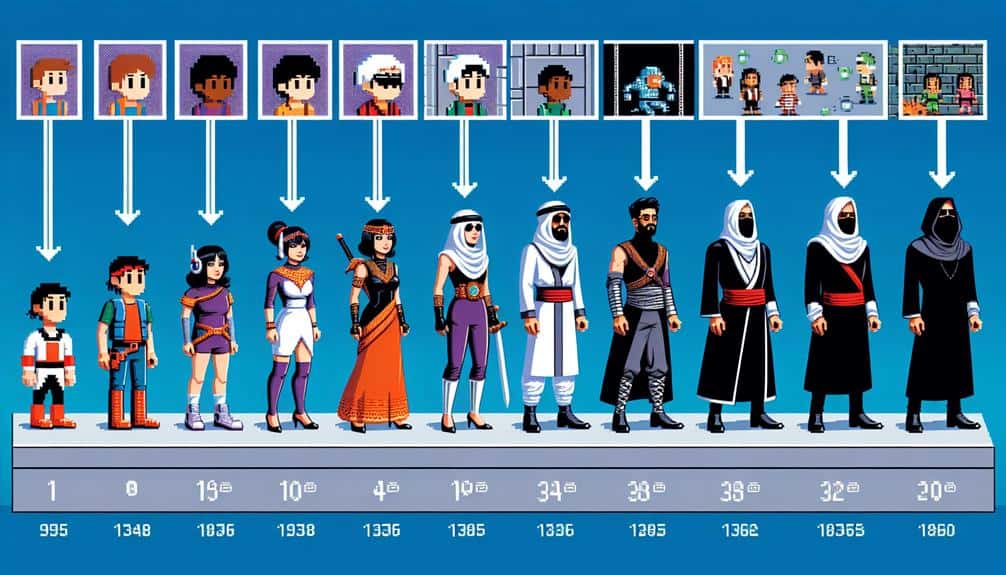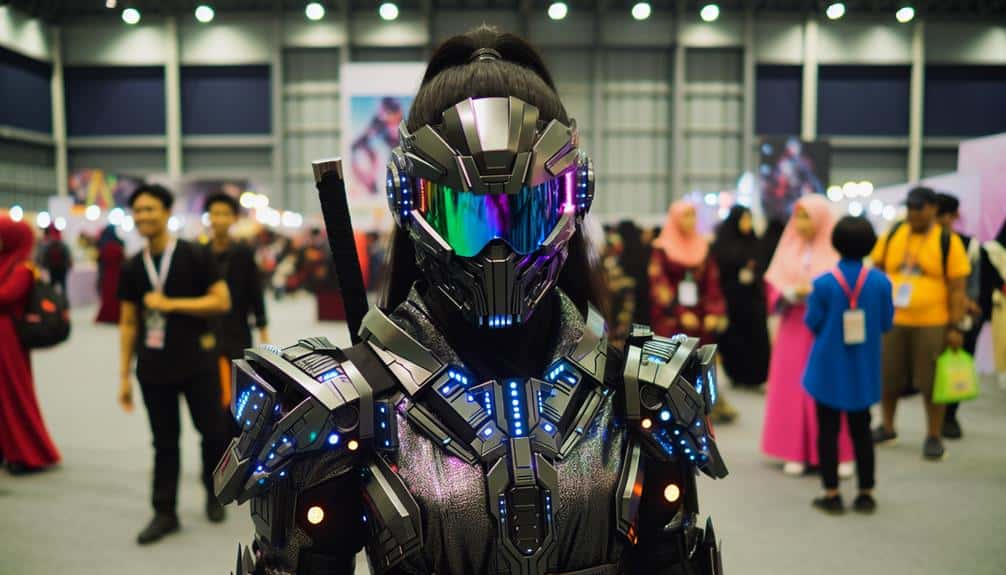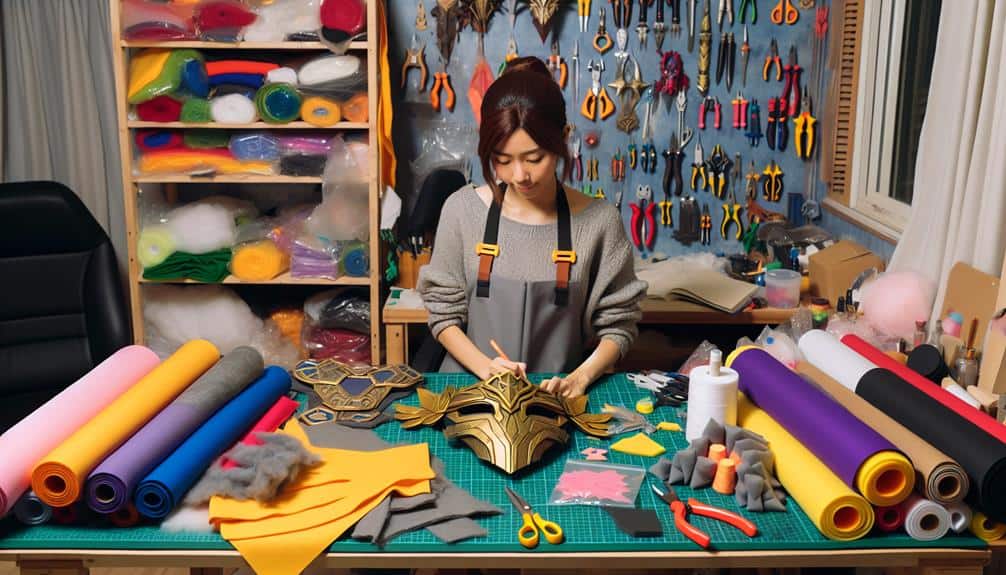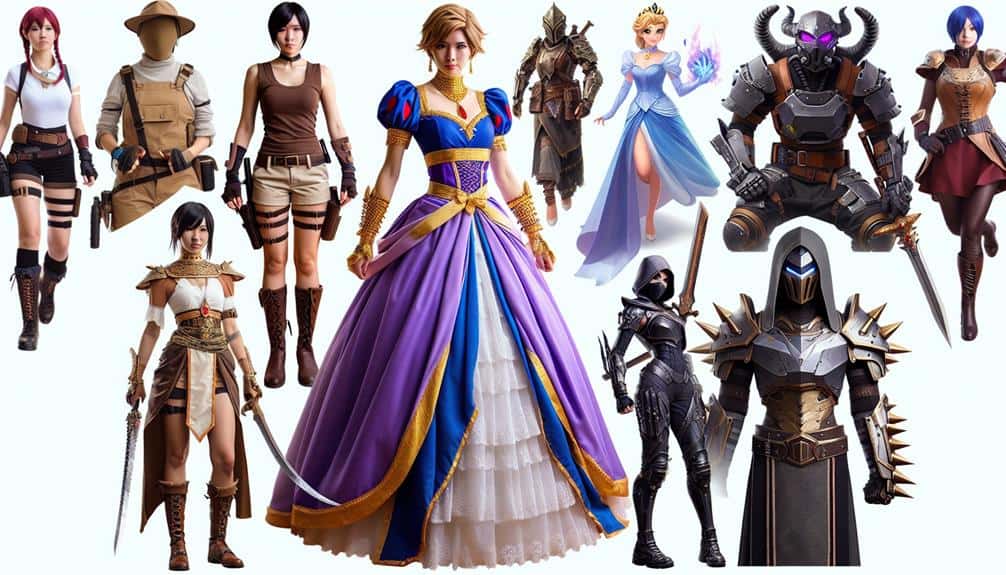Imagine attending a gaming convention and seeing a cosplayer dressed as Ezio Auditore from the Assassin's Creed series. This iconic character has been a favorite among fans for years, but have you ever paused to contemplate how video game character cosplays have evolved over time?
From humble beginnings to elaborate creations, the evolution of these cosplays tells a fascinating story of creativity, dedication, and innovation. Explore the journey of video game character cosplays through different eras and discover the trends that have shaped this vibrant subculture.
Key Takeaways
- Video game character cosplays have evolved from niche hobby to global phenomenon.
- Improved gender representation and cultural sensitivity in cosplays.
- Technological advancements like VR and 3D printing revolutionize costume creation.
- Social media platforms amplify cosplay trends, fostering community and creativity.
Early Beginnings of Video Game Cosplays
In the early days of video game culture, cosplaying as video game characters began to gain popularity among enthusiasts and fans. The historical origins of video game character cosplays can be traced back to the late 1970s and early 1980s when gaming conventions and fan gatherings provided platforms for individuals to showcase their love for video game characters through elaborate costumes. At that time, cosplaying was a niche hobby practiced by a small group of dedicated fans, but it laid the foundation for what would later become a global phenomenon.
The cultural impact of these early video game character cosplays can't be understated. They helped foster a sense of community among gamers, allowing them to express their creativity and passion for gaming in a tangible and visible way. As video game culture continued to evolve, so did the practice of cosplaying, eventually leading to the diverse and vibrant cosplay scene that exists today. These early beginnings set the stage for the rise of popular video game cosplays in the years to come.
Rise of Popular Video Game Cosplays
The emergence of popular video game cosplays can be attributed to the intersection of gaming culture with mainstream entertainment and social media platforms. As video games gained more recognition in popular culture, characters like Lara Croft from 'Tomb Raider' and Mario from 'Super Mario Bros.' became iconic figures that fans wanted to embody through cosplay. This rise in popularity also brought attention to issues surrounding gender representation and cultural appropriation within the cosplay community.
Gender representation in video game cosplays has seen significant improvements over the years, with more diverse and empowering characters being celebrated. Cosplayers now have a plethora of options, from strong and independent female protagonists to complex male characters, allowing for a more inclusive and representative environment.
However, the issue of cultural appropriation continues to be a topic of discussion within the cosplay community. Cosplayers must be mindful of the cultural significance of the characters they choose to portray and so they do so respectfully, avoiding stereotypes or offensive portrayals. By addressing these concerns, the world of video game cosplays can continue to evolve into a more inclusive and respectful space for all enthusiasts.
Technological Advancements in Video Game Cosplays
Amidst the dynamic landscape of video game cosplays, a wave of technological advancements has revolutionized the way enthusiasts bring their favorite characters to life. Virtual reality (VR) has emerged as a game-changer in the cosplay world, allowing individuals to immerse themselves in a digital world where they can interact as their beloved gaming personas. This innovation enables cosplayers to embody characters more authentically, enhancing the overall cosplay experience.
Additionally, 3D printing technology has impacted the creation of intricate costumes and props. Cosplayers can now design and produce detailed armor, weapons, and accessories with precision and speed, bringing a new level of realism to their portrayals. The ability to custom-make components through 3D printing has opened up endless possibilities for cosplayers to showcase their craftsmanship and attention to detail.
Incorporating these technological advancements has elevated video game cosplays to new heights, blurring the lines between reality and virtuality. As technology continues to advance, the future of video game cosplays holds even more exciting prospects for enthusiasts looking to push the boundaries of creativity and innovation.
Influence of Social Media on Video Game Cosplays
Social media platforms play a pivotal role in shaping the landscape of video game cosplays, influencing trends and connecting enthusiasts worldwide. The impact of social media on video game cosplays is undeniable, driving creativity and fostering a strong sense of community and engagement among fans.
Here are four key ways social media influences video game cosplays:
- Global Reach: Social media allows cosplayers to showcase their creations to a vast audience, transcending geographical boundaries and reaching fans from all corners of the world.
- Trend Amplification: Platforms like Instagram and TikTok amplify cosplay trends, propelling popular characters and styles to the forefront of the community's attention.
- Instant Feedback: Cosplayers receive instant feedback on their work, enabling them to refine their craft, experiment with new ideas, and stay current with evolving trends.
- Community Building: Social media platforms create virtual spaces where cosplayers can interact, share tips, collaborate on projects, and form lasting friendships based on their mutual love for video game cosplays.
Future Trends in Video Game Cosplays
Exploring upcoming trends in video game cosplays reveals a dynamic evolution of creative expressions and fan engagement within the gaming community. Two significant future trends to watch out for are virtual reality (VR) cosplays and AI-generated costumes.
Virtual reality cosplays are poised to revolutionize the way cosplayers interact with their favorite video game characters. With VR technology becoming more accessible, cosplayers can immerse themselves in virtual worlds, bringing their costumes to life in ways never seen before. Imagine walking through a digital landscape as your favorite character, with every movement and gesture mimicked in real-time.
On the other hand, AI-generated costumes are set to redefine the boundaries of creativity in cosplay. By utilizing artificial intelligence algorithms, cosplayers can design intricate and unique costumes that push the limits of imagination. These AI-generated costumes could range from elaborate armor sets to fantastical creature designs, opening up a whole new field of possibilities for cosplayers looking to stand out.
Frequently Asked Questions
How Has the Cultural Significance of Video Game Character Cosplays Evolved Over Time?
Over time, the cultural significance of video game character cosplays has evolved. Popular characters like Mario and Lara Croft attract attention, but lesser-known ones also gain recognition. This evolution reflects the growing impact of gaming on fashion and pop culture.
What Are Some Lesser-Known Video Game Characters That Have Gained Popularity in the Cosplay Community?
When exploring the world of cosplay trends, you may encounter hidden gems like underrated characters gaining popularity. Plunge into cosplay communities to discover the rising stars, showcasing how character popularity can shine unexpectedly.
How Do Video Game Character Cosplays Differ From Cosplay of Characters From Other Forms of Media, Such as Movies or TV Shows?
In video game character cosplays, gender representation plays a significant role, with fans creatively interpreting characters. Authenticity is important, reflecting fan culture's attention to detail. This sets video game cosplays apart from those of movies or TV shows.
What Role Do Video Game Developers Play in Promoting and Supporting the Cosplay Community?
Developers actively engage with cosplayers by organizing events, sharing character designs, and offering support. Their involvement fosters community growth, showcases creativity, and strengthens the bond between players and creators. It's a mutually beneficial relationship.
Are There Any Ethical Considerations to Keep in Mind When Cosplaying as a Video Game Character, Especially in Regards to Cultural Appropriation or Stereotypes?
When cosplaying as a video game character, it's essential to ponder cultural sensitivity and proper character representation. Avoiding stereotypes and cultural appropriation is key. Your portrayal should honor the character's origins and respect diverse backgrounds.



